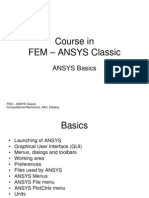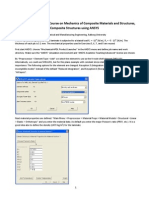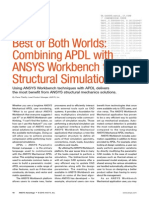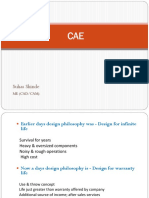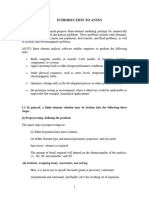University of Alberta - ANSYS Tutorials: Getting Started
Uploaded by
mhk665University of Alberta - ANSYS Tutorials: Getting Started
Uploaded by
mhk665University of Alberta - ANSYS Tutorials
http://www.mece.ualberta.ca/tutorials/ansys/ ANSYS is a general purpose finite element modeling package for numerically solving a wide variety of mechanical problems. These problems include: static/dynamic structural analysis (both linear and non-linear), heat transfer and fluid problems, as well as acoustic and electromagnetic problems. These tutorials have been created using ANSYS 5.7.1, therefore, make note of small changes in the menu structure if you are using an older version. This web site has been broken into the following five sections. Getting Started A brief introduction to using ANSYS. This includes a quick explanation of the stages of analysis, how to start ANSYS, and the use of the windows in ANSYS. Basic Tutorials Detailed tutorials outlining basic structural analysis using ANSYS. It is recommended that you complete these tutorials in order as each tutorial builds upon skills taught in previous examples. Advanced Tutorials Complex skills such as dynamic analysis and optimization are explored in this section. It is recommended that you have completed the Basic Tutorials prior to attempting these tutorials. Command Line Files Example problems solved using command line coding only, in addition to several files to help you to generate your own command line files. Utilities Theses files provide further details on using ANSYS. These files will be helpful to you once you are comfortable using ANSYS and are ready to complete your own finite element analysis problems. Convergence Testing, Saving/Restoring Jobs, and working with Pro/E are a few of the topics covered. Basic Tutorials The following documents will lead you through several example problems using ANSYS. ANSYS 5.7.1 was used to create these tutorials, therefore, if you are using an older version of ANSYS make note of small changes in the menu structure. Complete these tutorials in order as each tutorial will build on skills taught in the previous example. Bicycle Space Frame Basic functions will be shown in detail to provide you with a general knowledge of how to use ANSYS. This tutorial should take approximately an hour and a half to complete. Plane Stress Bracket Boolean operations, plane stress and uniform pressure loading will be introduced in the creation and analysis of this 2-Dimensional object. Solid Modeling This tutorial will introduce techniques such as filleting, extrusion, copying and working plane orienation to create 3Dimensional objects.
You might also like
- University of Alberta - Ansys Tutorials PDFNo ratings yetUniversity of Alberta - Ansys Tutorials PDF639 pages
- Design and Analysis of Compressor Base Frame For Weight ReductionNo ratings yetDesign and Analysis of Compressor Base Frame For Weight Reduction11 pages
- ANSYS Mechanical APDL Introductory Tutorials100% (1)ANSYS Mechanical APDL Introductory Tutorials106 pages
- Reverse Engineering Gear Demo (PDFDrive)No ratings yetReverse Engineering Gear Demo (PDFDrive)120 pages
- Theory Manual For The Tuned Mass Damper Module in FAST v8: March 2015No ratings yetTheory Manual For The Tuned Mass Damper Module in FAST v8: March 201510 pages
- UPM-ANSYS Online Masters Degree CatalogueNo ratings yetUPM-ANSYS Online Masters Degree Catalogue31 pages
- Introduction To Simulation With ANSYS MeNo ratings yetIntroduction To Simulation With ANSYS Me1 page
- ANSYS Mechanical APDL Command Reference: Release 16.2No ratings yetANSYS Mechanical APDL Command Reference: Release 16.236 pages
- ANSYS Mechanical APDL Introductory Tutorials Huy KLJHLKJHLK100% (1)ANSYS Mechanical APDL Introductory Tutorials Huy KLJHLKJHLK142 pages
- Mechanical APDL Advanced Analysis Techniques Guide - AnsysNo ratings yetMechanical APDL Advanced Analysis Techniques Guide - Ansys380 pages
- Flexural and Shear Moduli of Full-Section Fiber Reinforced Plastic FRP Pultruded July) LC BANKNo ratings yetFlexural and Shear Moduli of Full-Section Fiber Reinforced Plastic FRP Pultruded July) LC BANK6 pages
- Large Storage Tanks Foundation Settlement Structural Mechanics Characteristics AnalysisNo ratings yetLarge Storage Tanks Foundation Settlement Structural Mechanics Characteristics Analysis7 pages
- ANSYS Workbench 2021 R1: A Tutorial Approach, 4th EditionFrom EverandANSYS Workbench 2021 R1: A Tutorial Approach, 4th EditionNo ratings yet
- Damage Mechanics in Metal Forming: Advanced Modeling and Numerical SimulationFrom EverandDamage Mechanics in Metal Forming: Advanced Modeling and Numerical Simulation4/5 (1)
- High Irradiance UV/Condensation Testers Allow Faster Accelerated Weathering Test ResultsNo ratings yetHigh Irradiance UV/Condensation Testers Allow Faster Accelerated Weathering Test Results8 pages
- Aspects of Poly (Ethylene Terephthalate) Degradation For Archival Life and Environmental DegradationNo ratings yetAspects of Poly (Ethylene Terephthalate) Degradation For Archival Life and Environmental Degradation23 pages
- The Bank of Punjab The Bank of Punjab The Bank of Punjab The Bank of PunjabNo ratings yetThe Bank of Punjab The Bank of Punjab The Bank of Punjab The Bank of Punjab2 pages
- PO Box 1372 GPO Islamabad Jobs Application Form 2016No ratings yetPO Box 1372 GPO Islamabad Jobs Application Form 20161 page
- Your User Name: mhk665 Your PUK code:YW3JW-S1LFE-ARZRQ-MVBND-7H8LCNo ratings yetYour User Name: mhk665 Your PUK code:YW3JW-S1LFE-ARZRQ-MVBND-7H8LC1 page
- Meem 4403 Cad Methods Lab Instructions TUTORIAL 1: Sketching and Basic OperationsNo ratings yetMeem 4403 Cad Methods Lab Instructions TUTORIAL 1: Sketching and Basic Operations1 page
- Meem 4403 Computer-Aided Design Methods Optimization PracticeNo ratings yetMeem 4403 Computer-Aided Design Methods Optimization Practice2 pages
- Meem 4403 Computer-Aided Design Methods Bezier Curve and Surface Evaluation Practice - FALL 2005No ratings yetMeem 4403 Computer-Aided Design Methods Bezier Curve and Surface Evaluation Practice - FALL 20056 pages
- Meem 4403 Computer-Aided Design Methods Solid Modeling Data Structures - Practice QuestionsNo ratings yetMeem 4403 Computer-Aided Design Methods Solid Modeling Data Structures - Practice Questions2 pages




